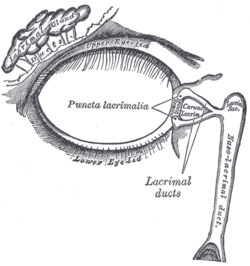Dacryocystocele
Editor-In-Chief: Prab R Tumpati, MD
Obesity, Sleep & Internal medicine
Founder, WikiMD Wellnesspedia &
W8MD medical weight loss NYC and sleep center NYC
| Dacryocystocele | |
|---|---|

| |
| Synonyms | Nasolacrimal duct cyst, Amniotocele |
| Pronounce | N/A |
| Specialty | N/A |
| Symptoms | Tearing, swelling near the inner corner of the eye |
| Complications | Infection, dacryocystitis |
| Onset | Neonatal |
| Duration | Varies |
| Types | N/A |
| Causes | Blockage of the nasolacrimal duct |
| Risks | Congenital anomalies |
| Diagnosis | Clinical examination, imaging |
| Differential diagnosis | Dacryocystitis, conjunctivitis |
| Prevention | N/A |
| Treatment | Massage, probing, surgery |
| Medication | Antibiotics if infected |
| Prognosis | N/A |
| Frequency | Rare |
| Deaths | N/A |
Dacryocystocele
Illustration of a dacryocystocele A dacryocystocele is a rare condition that affects the lacrimal system, specifically the lacrimal sac. It is characterized by the dilation and obstruction of the lacrimal sac, leading to the accumulation of tears and mucus. This condition primarily affects infants, although it can also occur in adults.
Symptoms
The most common symptom of a dacryocystocele is a bluish swelling in the inner corner of the eye, known as the lacrimal sac. This swelling is often accompanied by excessive tearing, discharge, and redness of the affected eye. In some cases, the dacryocystocele may become infected, leading to additional symptoms such as fever and pain.
Causes
Dacryocystoceles are typically caused by a blockage in the nasolacrimal duct, which is responsible for draining tears from the eye into the nasal cavity. This blockage can be congenital, meaning it is present at birth, or it can develop later in life due to trauma, infection, or inflammation. In infants, the most common cause of dacryocystoceles is a membrane or valve-like structure at the lower end of the nasolacrimal duct, known as the Hasner valve, failing to open properly.
Diagnosis
A dacryocystocele is usually diagnosed through a physical examination of the affected eye. The doctor may gently press on the lacrimal sac to check for swelling and evaluate the flow of tears. In some cases, additional tests such as a dye disappearance test or an imaging study, like a dacryocystogram, may be performed to confirm the diagnosis and determine the extent of the blockage.
Treatment
The treatment of a dacryocystocele depends on the severity of the condition and the age of the patient. In infants, gentle massage of the lacrimal sac and warm compresses may be sufficient to relieve the blockage and promote tear drainage. If these conservative measures fail, a procedure called probing and irrigation may be performed to open the nasolacrimal duct. In adults, surgical intervention is often required to remove the obstruction and restore normal tear drainage.
Complications
If left untreated, a dacryocystocele can lead to recurrent infections of the lacrimal sac, known as dacryocystitis. This can cause pain, swelling, and redness in the affected eye, as well as fever and general malaise. In severe cases, the infection may spread to the surrounding tissues, leading to cellulitis or abscess formation.
References
See also
Transform your life with W8MD's budget GLP-1 injections from $125.
W8MD offers a medical weight loss program to lose weight in Philadelphia. Our physician-supervised medical weight loss provides:
- Most insurances accepted or discounted self-pay rates. We will obtain insurance prior authorizations if needed.
- Generic GLP1 weight loss injections from $125 for the starting dose.
- Also offer prescription weight loss medications including Phentermine, Qsymia, Diethylpropion, Contrave etc.
NYC weight loss doctor appointments
Start your NYC weight loss journey today at our NYC medical weight loss and Philadelphia medical weight loss clinics.
- Call 718-946-5500 to lose weight in NYC or for medical weight loss in Philadelphia 215-676-2334.
- Tags:NYC medical weight loss, Philadelphia lose weight Zepbound NYC, Budget GLP1 weight loss injections, Wegovy Philadelphia, Wegovy NYC, Philadelphia medical weight loss, Brookly weight loss and Wegovy NYC
|
WikiMD's Wellness Encyclopedia |
| Let Food Be Thy Medicine Medicine Thy Food - Hippocrates |
Medical Disclaimer: WikiMD is not a substitute for professional medical advice. The information on WikiMD is provided as an information resource only, may be incorrect, outdated or misleading, and is not to be used or relied on for any diagnostic or treatment purposes. Please consult your health care provider before making any healthcare decisions or for guidance about a specific medical condition. WikiMD expressly disclaims responsibility, and shall have no liability, for any damages, loss, injury, or liability whatsoever suffered as a result of your reliance on the information contained in this site. By visiting this site you agree to the foregoing terms and conditions, which may from time to time be changed or supplemented by WikiMD. If you do not agree to the foregoing terms and conditions, you should not enter or use this site. See full disclaimer.
Credits:Most images are courtesy of Wikimedia commons, and templates, categories Wikipedia, licensed under CC BY SA or similar.
Translate this page: - East Asian
中文,
日本,
한국어,
South Asian
हिन्दी,
தமிழ்,
తెలుగు,
Urdu,
ಕನ್ನಡ,
Southeast Asian
Indonesian,
Vietnamese,
Thai,
မြန်မာဘာသာ,
বাংলা
European
español,
Deutsch,
français,
Greek,
português do Brasil,
polski,
română,
русский,
Nederlands,
norsk,
svenska,
suomi,
Italian
Middle Eastern & African
عربى,
Turkish,
Persian,
Hebrew,
Afrikaans,
isiZulu,
Kiswahili,
Other
Bulgarian,
Hungarian,
Czech,
Swedish,
മലയാളം,
मराठी,
ਪੰਜਾਬੀ,
ગુજરાતી,
Portuguese,
Ukrainian
Contributors: Prab R. Tumpati, MD

